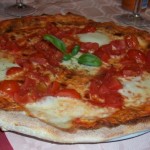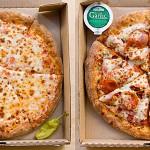The fascinating thing about pizza is that it says more about national cultures than it does about food. After all, a pizza is essentially only a dish of fresh-baked bread, typically topped with tomato sauce, cheese and a variety of meat and veg, served as fast food. Where could you possibly cultivate any significant flag-waving characteristics with something so simple, you might say.
Actually, that was quite easy. Pizza-like dishes have been around since Ancient Greek times, but the dish is most closely associated in modern times with the Italians. To Italian culture the pizza was just a snack, some hot bread served maybe with a touch of mozzarella, a little olive oil and not much else, typically cooked in a wood-burning oven to give the dough the optimum flavour. From Wikipedia:
Modern pizza originated in Italy as the Neapolitan flatbread. A popular urban legend holds that the archetypal pizza, Pizza Margherita, was invented in 1889, when the Royal Palace of Capodimonte commissioned the Neapolitan pizzaiolo Raffaele Esposito to create a pizza in honor of the visiting Queen Margherita. Of the three different pizzas he created, the Queen strongly preferred a pie swathed in the colors of the Italian flag: red (tomato), green (basil), and white (mozzarella). Supposedly, this kind of pizza was then named after the Queen as Pizza Margherita, though recent research casts doubt on this legend.
But the point was and is that in the Italian tradition, pizza is a very simple rustic dish, maybe the Italian equivalent of a toasted sandwich – or it was until the panini was invented, at any rate. It comes in two basic styles: pizza rosso (with a tomato sauce) or pizza bianchi (without.) It is simple as you like and focuses on the quality of flavours. Visit the Naples area and eat Campanian pizza, and you will find a product much like it has been eaten for many Centuries. The good old Margherita is still best to many, including my son!
In short, tradition counts for much, and that’s how Italians like it. What counts are the quality of the raw materials and the skill of the chef to create a perfectly uniform dough with just the right amount of toppings, then cook it so the bottom is scorched but not burned, the cheese melted and stringy. It should taste at once crisp, redolent of the woody smokiness of the oven, yet gooey and unctuous at the same time – that’s what pizzas should be and why, when done well, they can taste gorgeous.
Such rustic dishes were taken by Italians emigrating to the USA in the early years of the 20th Century. From that point on pizza morphed into the American style, highly reflective of American entrepreneurial culture, whereby emphasis is placed on innovation and going one step ahead of the competition. In the American tradition, pizza purveyors grew into global franchised chains with commercially designed mass-market pizza ovens: American cultural imperialism began to sell pizza back from whence it came, distorted but marketed to the hilt. To put it bluntly, pizza became commodotised.
Where the originals were literally “thin and crispy”, that term became a © trademark. Deep pan pizzas followed along with “pizza pie”, “stuffed crusts” and many more variants. Pepperoni and cheese became the most popular topping, but millions of customised combinations sprouted to please the masses. New favourites included “Hawaiian” with ham and pineapple; vegetarian combos appeared for veggies, and all-meat versions for carnivores; spicy mixtures included fresh chillis. And every single one came with promotions designed to make us order and buy yet more. Deliveries made it easy for us to pick up the phone, place our order and find a scooter rider at our door 30 minutes later with a box containing our lukewarm pizza.
That is not an entirely fair description, since there are equally up-market pizza restaurants, whose combinations are often unique and do use quality ingredients – but in ways the Italians would never contemplate. For example, the 2012 winner of one best pizza contest was Goodfellas restaurant on Staten Island, courtesy of their “tequila pie” pizza (see link above.)
For the record there are several such competitions, including the World Pizza Championships, all of which obtain different results – but then they probably have different criteria by which to judge the finished pizzas. No doubt you would have to be a genuine expert with a long track record to appreciate the value of one sourdough base above another, much as “noses” within the wine industry can tell you volumes about the quality of one vintage from one chateau against another. However, the following description from the Guardian provides a wonderfully vivid view of how seriously it is taken back in the old country – Naples is still the heart of great pizza-making!
In a sports arena in an edgy suburb of Naples, the atmosphere is tense as big and brawny men emerge from their prep stations carrying mozzarella, dough and tomatoes. Family and friends yell encouragement and pat them on the back as they make their way towards the stage, like prizefighters going into a boxing ring. Battle commences in front of specially installed wood-burning ovens and for the next few hours delicious thin-crust pizzas, about as far away as it’s possible to get from the over-laden lumps of stodge most of us find when we open pizza delivery boxes, are cooked and presented to a panel of judges.
Naples is the spiritual home of the pizza and the true Neapolitan pizza is even recognised by the EU as a “copyrighted” traditional specialty. A proper margherita must have mozzarella “from the southern Apennines,” and be served with locally grown tomatoes and only a leaf or two of basil. It has to be round and no more than 35cm in diameter, with a rim not more than two centimetres high.
With 12,000 pizzerias in the city, and some 25,000 in the whole region of Campania, every self-respecting Neapolitan will eat pizza at least once a week. The top pizzaioli, or pizza makers, therefore, are admired, even revered, which is why contestants are waiting impatiently for the results of the Naples Pizza Championship, held annually in Italy’s rough-and-ready but highly alluring third city.
There are other categories in the competition – pizza by the metre, gluten-free pizza, creative pizza and freestyle acrobatics in which performers send dinner-plate sized rounds of white dough flying through the air – but it’s the person who is judged to have made the best pizza tradizionale who takes away the top prize.
As the judging slips are counted the air of expectancy is palpable.
Pizza-making is a macho thing. There are only a couple of women out of all the competitors and most of the pizzaioli seem to be big, muscled men with shoulders like hams, wearing aprons, bandanas and scarves.
Pasquale Parziale, 58, has been cooking pizzas for 42 years. A true Neapolitan idol, he has won just about every prize going in his long career and now acts as a father figure to youngsters trying to get a start in the business. “It’s strength, it’s passion,” he says. “What’s pizza? It’s flour, water, salt and a bit of yeast. It’s how you work the dough, how you look after your oven, and what you put on the pizza. That’s how a good pizzaiolo stands out from mediocrity.”
The verdict is in and the winner is Pasquale Sivo, who comes on to the stage to thunderous applause. The judges have given him top marks for his perfectly round pizza, with a slightly burned, crunchy crust. They also approve of his base of crushed tiny tomatoes grown in the volcanic soil near Mount Vesuvius, as well his perfectly placed splodges of mozzarella.
Clutching his award afterwards, he says he has been making pizzas at his pizzeria, La Sorrentina, for 28 years. “It’s a life,” he says, tears of pride welling up in his eyes, before he is led away to celebrate by his family. La Sorrentina is a typical rustic Neapolitan pizzeria about 10km from the centre of Naples in Fratta Maggiore. It’s a family-run place – his two brothers, wife, son and father-in-law all work there. He offers 30 types of pizza but his speciality is the true Neapolitan. His message to British holidaymakers is “Come and taste real pizza!”
· Best Neapolitan Pizza 2006: Pasquale Sivo, La Sorrentina, 37 Via Domenico Pirozzi, Fratta Maggiore (00 39 338 3248615), closed Mondays. Other recommended pizzerias: Pizzeria di Matteo, 94 Via Tribunale (+081 455 262). Pizzeria Pellone, 93 Via Nazionale (+081 553 8614). Pizzeria Da Michele, 1 Via Cesare Sersale (+081 553 9204), closed Sundays. Pizzeria Tappost, 27 Via Casalanno, Marano (+081 586 2002), closed Mondays. O’Scapricciatiello, via Orofino Torrione, Salerno (+089 995 1260), closed Tuesdays. London to Naples by Eurostar and sleeper train costs £142 rtn. See seat61.com/italy.










